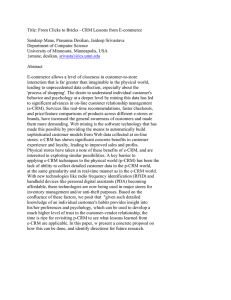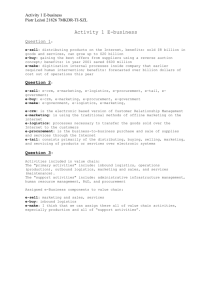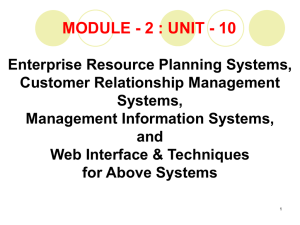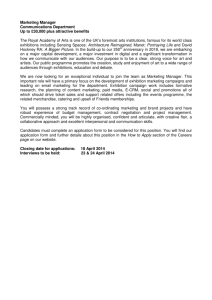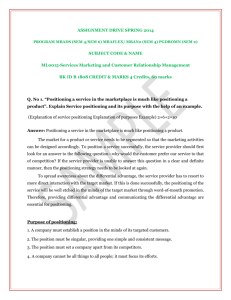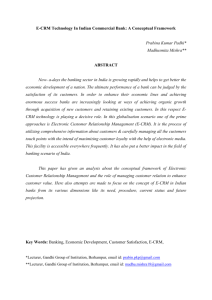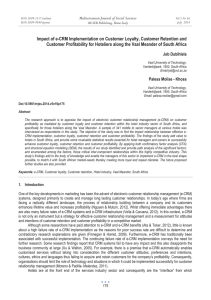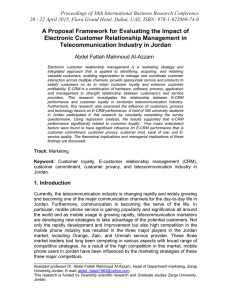E-CRM - Andrew Khosugih – 1501156143
advertisement
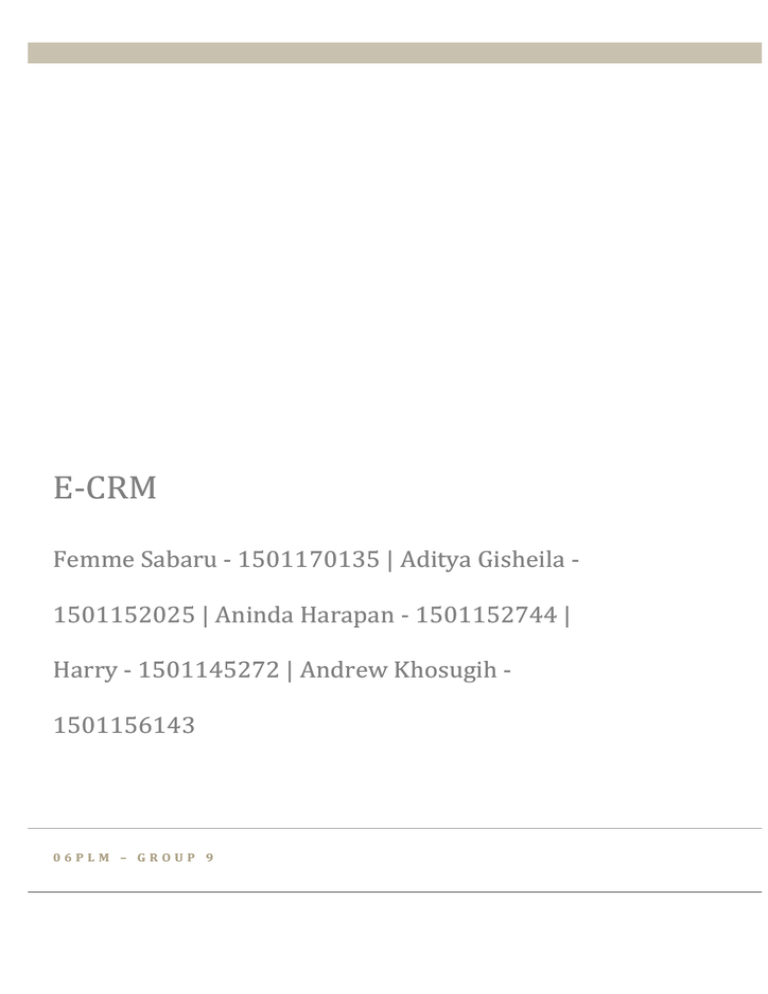
E-CRM Femme Sabaru - 1501170135 | Aditya Gisheila 1501152025 | Aninda Harapan - 1501152744 | Harry - 1501145272 | Andrew Khosugih 1501156143 06PLM – GROUP 9 ABSTRACT PURPOSE TO WRITING is to understand what e-crm is and also how to create a good e-crm system. E-crm is electronic customer relationship manager which has the function to attracting, maintaining, and enhancing customer relationship within organization. In implementing e-crm solution, organization must consider between the non-electronic solution or the cloud solution, which one of those solution is the most suited solution for the organization. ANALYSIS METHODOLOGY that we used to make this writings is the literature study which collecting all data about e-crm which include explanation and how to implement the e-crm. RESULT ACHIEVED is understanding about e-crm completely, also to have the knowledge about differentiation between crm and e-crm. Also to understand how ecrm works, the methodology in implementing e-crm , considering the best e-crm solutions for organization, modules inside e-crm, levels in e-crm and the parameter how a success e-crm is. CONCLUSION is with all the explanation in this paper, reader will understand all about e-crm . Keywords : e-crm, e-crm solutions, differentiation between e-crm and crm. Table of Contents ABSTRACT .................................................................................................................. 2 CHAPTER 1 INTRODUCTION .................................. Error! Bookmark not defined. Background............................................................................. Error! Bookmark not defined. Scope........................................................................................ Error! Bookmark not defined. Objective and Benefits ........................................................... Error! Bookmark not defined. Methodology ........................................................................... Error! Bookmark not defined. CHAPTER 2 LITERATURE REVIEW .................................................................... 4 Definition of Business.......................................................................................................... 6 Definition of Enterprise ...................................................................................................... 6 Definition of Resource ........................................................................................................ 6 Definition of Planning ......................................................................................................... 6 Definition of Enterprise Resource Planning ........................ Error! Bookmark not defined. CHAPTER 3 DISCUSSION........................................................................................ 6 Advantages of ERP ................................................................ Error! Bookmark not defined. Disadvantages of ERP ............................................................ Error! Bookmark not defined. Industries with ERP Application .......................................... Error! Bookmark not defined. ERP Tool ................................................................................. Error! Bookmark not defined. Effectiveness of using ERP .................................................... Error! Bookmark not defined. Financial Advantages of ERP ............................................... Error! Bookmark not defined. CHAPTER 4 CONCLUSION ..................................................................................... 7 Conclusion............................................................................... Error! Bookmark not defined. Suggestion ............................................................................... Error! Bookmark not defined. References ................................................................................................................... 12 BIOGRAPHY ............................................................................................................. 13 Chapter 1 Introduction Background The world in 21st century is not the same as the others. The way people talk even interact with each other are not the same. Technological thing are more used nowadays. Everyone holding smart-phones, ipad, or other gadget. Even company also implement technological things to reach their customer, from online shopping until customer relationship management. As we can see before, customer tends to sent message towards newspaper or letter to the company to speak their suggestions or comment about a product or services, or telephoning the call center. That methods are still implemented but since people are already using smart-phones and everything is related to web nowadays, so E-CRM start to implement in several companies. In order to get closer with customer easily and let customer gives comment and suggestions towards the products or services, e-CRM could helps a lot. E-CRM is not just the call center, self-service website. It’s an improvement in manual customer relationship management. E-CRM also helps company to perform better. E-CRM is not only helps company in on division but very suggestions or comment that customer made will be seen in every division. Customer can easily post their reviews and rate the company on web by using their smart-phones or other gadgets. E-CRM is made in order to understand customer more and to stored what’s customer’s need so company can perform and produce better products or services. Objectives and Benefits The objectives of this E-CRM themed paper is to give explanation and understanding about E-CRM. Benefits : Figure out about E-CRM Obtain more knowledge about E-CRM Methodology Method that being used on this paper : Data collection Method Literature study through e-books and journals. CHAPTER 2 Literature Review Definition of Electronic Definition of electronic is the device or technology associated with or employing low voltage current and solid state integrated circuits or components, usually for transmission and/or processing of analog or digital data. Definition of Customer Definition of customer is a party that receives or consumes products (goods or services) and has the ability to choose between different products and suppliers. Definition of Relationship Definition of relationship is a connection between variables, such as correlation, or between people, such as marriage. Definition of Management Definition of management is the organization and coordination of the activities of a business in order to achieve defined objectives. Often included as a factor of production along with machines, materials and money. Definition of Customer Relationship Management Definition of Customer Relationship Management is a management philosophy to which a company’s goals can be best achieved through identification and satisfaction of the customer’s stated and unstated needs and wants. It helps in profiling prospects, understanding their needs, and in building relationships with them by providing the most suitable products and enhanced customer service. CHAPTER 3 DISCUSSION e-CRM Definition e-CRM (Electronic Customer Relationship Management) is an enterprises using IT to integrate internal organization resources and external marketing strategies to understand and fulfill their customers needs. Comparing with traditional CRM, the integrated information for eCRM intra organizational collaboration can be more efficient to communicate with customers. e-CRM concerns all forms of managing relationships with customers making use of IT (Information Technology). e-CRM direct all the CRM functions with the use of the net environment i.e., intranet, extranet and internet. Electronic CRM concerns all forms of managing relationships with customers making use of information technology (IT). e-CRM is not just your call center, self-service Web site, sales force automation tool or the analysis of customers' purchasing behaviors. E-CRM is all of these initiatives working together to enable you to more effectively respond to your customers' needs and to market to them on a one-to- one basis. It's about the customer, not any individual piece of technology. If we evaluate and understand how our customers behave and how we need to respond to them, then we can begin to understand the component pieces of e- CRM. e- CRM success factors: 1. Developing customer-centric strategies - Acquisition of information about the customer - What actions to take as a result of this knowledge 2. Redesigning workflow management systems - Re-engineering the business process around the customer - All interactions with customers recorded in one place 3. Re-engineering work processes - Respond to customers through their preferences of choice - E-mail, phone, chat line, etc. 4. Supporting with the right technologies - Technology update is required - Custom changes towards initial technology implementation - Product centric focus vs. customer centric focus e- CRM Advantages compare to CRM: - Traditional CRM approach: call centers - Rapid growth of customer base - Sharp increase in service inquiries - Adding more customer service representatives would be costly - To improve customer’s experience in doing business with Sprint - Core differentiator in the industry/competitive advantage e- CRM Disadvantages: - Designing, creating and implementing IT projects has always been risky. Not only because of the amount of money that is involved, but also because of the high chances of failure. - Difficulty in measuring and valuing intangible benefits. - Failure to identify and focus on specific business problems. - Lack of active senior management sponsorship. - Poor user acceptance. - Trying to automate a poorly defined process. Differences of e-CRM and CRM method: Aspects Customer Approach e-CRM CRM The companies has built new model of The companies still using phones, faxes, technology in contacting the customers and through chatter in retail store when through Internet, mail addresses, wireless contacting the customers. chatting, and PDA technologies. Customization and Personalized individual views based on Differences audiences can be viewed based personalization of purchase and not for individual that needs time to information Individual has ability to customize view. history and preferences. track for more personal views. Interface Mostly depends on front end, which The depending on ERP systems and interacts with the back-end through use proving emphasis on the back end user. of ERP systems, data warehouses, and data marts. Client Does not have these requirements because the client uses the browser. The client must download and install many various applications that needed to be used for contact and it will meet difficulties when meets different platforms. System maintenance The more faster and cheaper because can The expensive and more costly when using and modification conducting and the system especially at different locations maintenance whenever there are browser and on various servers when conducting the and Internet. implementation and maintenance. implementation e-CRM Implementation Goal: - Offer an efficient customer self-service where customers could learn about products, purchase service plans, phones and accessories, manage their account, request service and support all in one place - Improve quality of service while reducing costs - Reduce the number of calls to the service center - Universal expand link to partners and suppliers - Integration of telephone, e-mail and Web environments - Allowed the company to bring together all the members of the customer service community: marketing and sales, finance and accounting, distribution - Customer access to every company function in one familiar pl (L. Ryals and A. Payne, 2001)ace - Customer interaction demand fulfill - eCRM return of investment cost in short period of time CHAPTER 4 CONCLUSION CONCLUSION E-crm is electronic customer relationship manager which has the function to attracting, maintaining, and enhancing customer relationship within organization. In implementing e-crm solution, organization must consider between the non-electronic solution or the cloud solution, which one of those solution is the most suited solution for the organization. E-CRM is all of these initiatives working together to enable you to more effectively respond to your customers' needs and to market to them on a one-to- one basis. e- CRM success factors: 1. Developing customer-centric strategies 2. Redesigning workflow management systems 3. Re-engineering work processes 4. Supporting with the right technologies e- CRM Advantages compare to CRM: - Traditional CRM approach: call centers - Rapid growth of customer base - Sharp increase in service inquiries - Adding more customer service representatives would be costly - To improve customer’s experience in doing business with Sprint - Core differentiator in the industry/competitive advantage e- CRM Disadvantages: Designing, creating and implementing IT projects has always been risky. Difficulty in measuring and valuing intangible benefits. Failure to identify and focus on specific business problems. Lack of active senior management sponsorship. Poor user acceptance. Trying to automate a poorly defined process. e-CRM Implementation Goal: - Offer an efficient customer self-service - Improve quality of service while reducing costs - Reduce the number of calls to the service center - Universal expand link to partners and suppliers - Integration of telephone, e-mail and Web environments - Allowed the company to bring together all the members of the customer service community: marketing and sales, finance and accounting, distribution - Customer access to every company function in one familiar place - Customer interaction demand fulfill - eCRM return of investment cost in short period of time SUGGESTION Because of the limitation of time, we are suggesting some necessary parts that need to be developed: We can discuss about e-crm implementation in a company The e-crm development The real e-crm activities Bibliography Bernard, S. A. (2012). EA3. In S. A. Bernard, EA3 : An Intorduction to Enterprise Architecture (p. 31). AuthorHouse. Chandra Satish, Ted J. Strickland. (2004). Technologial Differences Between CRM and eCRM. L. Ryals and A. Payne. (2001). Customer Relationship Management In Financial Services : Towards Information-Enabled Relationship Marketing. BIOGRAPHY A. Biography 1 Full Name (with title) Femme Lienda Hiwusala Sabaru 2 Gender Female 3 Major Information System 4 NIM 1501170135 5 D.O.B. February 22nd 1993 6 E-mail femme.sabaru@gmail.com 7 Tel. Number / HP 081999100630 B. Education History SD SMP SMA Institution Sekolah Dyatmika, Bali Sekolah Dyatmika, Bali SMA Taman Rama, Jimbaran Year 1999-2005 2005-2008 2008-2011 C. Rewards & Appreciations No Reward Type Institution Year A. Biography 1 Full Name (with title) Aditya Gisheila Nastiti Prameswara 2 Gender Female 3 Major Information System 4 NIM 1501152025 5 D.O.B. 19th October 1993 6 E-mail adityagh19@gmail.com 7 Tel. Number / HP 0811 877 3538 B. Education History SD SMP SMA Institution SDS Angkasa 1, Jakarta SMP N 103, Jakarta SMAT Krida Nusantara, Bandung Year 1999 – 2005 2005 – 2008 2008-2011 C. Rewards & Appreciations No Reward Type Institution Year A. Biography 1 Full Name (with title) Aninda Harapan 2 Gender Female 3 Major Information System 4 NIM 1501152744 5 D.O.B. April 22nd 1994 6 E-mail nindaaninda94@gmail.com 7 Tel. Number / HP 087883496826 B. Education History SD SMP SMA Institution Baptis Elim Kristen Ketapang 1 Kristen Ketapang 1 Year 1999-2005 2005-2008 2008-2011 C. Rewards & Appreciations No Reward Type Institution Year A. Biography 1 Full Name (with title) Andrew Khosugih 2 Gender Male 3 Major Information Systen 4 NIM 1501156143 5 D.O.B. 1st February 1993 6 E-mail Andrew_khosugih@yahoo.co.id 7 Tel. Number / HP 08988081295 B. Education History SD SMP SMA Institution Chandra Kusuma Chandra Kusuma Ricci 1 Year 1999-2005 2005-2008 2008-2011 C. Rewards & Appreciations No Reward Type Institution Year A. Biography 1 Full Name (with title) Harry 2 Gender Male 3 Major Information System 4 NIM 1501145272 5 D.O.B. April 5th 1993 6 E-mail harrybinusorg@gmail.com 7 Tel. Number / HP 087869551230 B. Education History SD SMP SMA Institution SD Methodist 3, Medan SMP Methodist 3, Medan SMA Methodist 2, Medan Year 1999-2005 2005-2008 2008-2011 C. Rewards & Appreciations No Reward Type Institution Year
